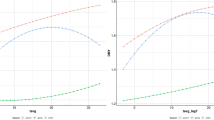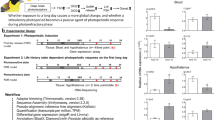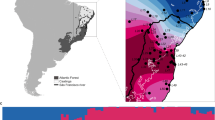Abstract
Seasonal breeding is common in mammals, particularly in habitats outside the tropics. Climate and availability of food are the ultimate factors that usually dictate the optimal time of year for a mammal to breed ; however, day length (photoperiod) often serves as the proximal cue to signal the onset or cessation of seasonal reproduction1. Some individuals in some populations of deer mice are reproductively responsive to photoperiod, while other individuals in the same population are not. As shown here, selection can dramatically alter the frequency of photoresponsiveness in a laboratory population in only two generations. To our knowledge this is the first demonstration of selection for reproductive photoresponsiveness in any mammal. By implication, some wild populations of deer mice must use multiple, genetic-based reproductive strategies, and the degree to which each such strategy is exhibited must be subject to rapid change in response to both seasonally and momentarily changing climatic and dietary conditions.
This is a preview of subscription content, access via your institution
Access options
Subscribe to this journal
Receive 51 print issues and online access
$199.00 per year
only $3.90 per issue
Buy this article
- Purchase on SpringerLink
- Instant access to full article PDF
Prices may be subject to local taxes which are calculated during checkout
Similar content being viewed by others
References
Sadleir, R. M. F. S. The Ecology of Reproduction in Wild and Domestic Mammals (Methuen, London, 1969).
Millar, J. S. Spec. Publ. Carnegie Mus. nat. Hist. 10, 253–266 (1984).
Bronson, F. H. Biol. Reprod. 32, 1–26 (1985).
Desjardins, C. & Lopez, M. J. in Testicular Development, Structure and Function (eds Steinberger, A. & Steinberger, E.) 381–388 (Raven, New York, 1980).
Johnston, P. G. & Zucker, I. Biol. Reprod. 44, 983–989 (1980).
Desjardins, C. Biol. Reprod. 24, 23A (1981).
Lynch, G. R., Heath, H. W. & Johnston, C. M. Biol. Reprod. 25, 475–480 (1981).
Desjardins, C. & Lopez, M. J. Endocrinology 112, 1398–1406 (1983).
Hoffman, K. Biol. Reprod. 30 Suppl. 1, 55 (1984).
Horton, T. H. Can. J. Zool. 62, 1741–1746 (1984).
Stetson, M. H., Elliott, J. A. & Goldman, B. D. Biol. Reprod. (in the press).
Drickamer, L. C. Behav. neur. Biol. 31, 82–90 (1981).
Vogt, F. D. & Lynch, G. R. Am. Zool 18, 109 (1978).
Zucker, I. in Biological Rhythms and Their Control Mechanisms (eds Suda M., Hayaisha, O. & Nakagawa, H.) 369–381 (Elsevier, New York, 1979).
Blank, J. L. & Desjardins, C. in Survival in the Cold (ed. Heller, C.) (Elsevier, New York, in the press).
Scheffer, T. H. J. Mammal. 5, 258–260 (1924).
Linduska, J. P. J. Wildl. Mgmt 6, 353–363 (1942).
Brown, H. L. Ecology 26, 308–309 (1945).
Fairbairn, D. J. Can. J. Zool. 55, 862–871 (1977).
Blank, J. & Desjardins, C. Am. J. Physiol. 248, R181–R189 (1985).
Murton, R. K., Westwood, N. J. & Thearle, R. J. P. J. Reprod. Fert. Suppl. 19, 563–577 (1973).
Author information
Authors and Affiliations
Rights and permissions
About this article
Cite this article
Desjardins, C., Bronson, F. & Blank, J. Genetic selection for reproductive photoresponsiveness in deer mice. Nature 322, 172–173 (1986). https://doi.org/10.1038/322172a0
Received:
Accepted:
Issue date:
DOI: https://doi.org/10.1038/322172a0
This article is cited by
-
Phenotypic plasticity of reproductive traits in response to food availability and photoperiod in white-footed mice (Peromyscus leucopus)
Oecologia (2006)
-
Spatial learning in deer mice: sex differences and the effects of endogenous opioids and 60 Hz magnetic fields
Journal of Comparative Physiology A (1996)
-
Genetic analyses of photoresponsiveness in the Djungarian hamster,Phodopus sungorus
Journal of Comparative Physiology A (1989)



